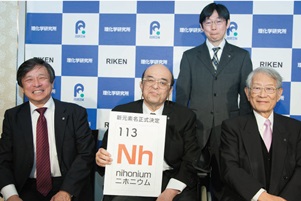Dec. 2, 2016 Special Feature Physics / Astronomy
Nihonium takes its place at the table
IUPAC has officially approved the names and symbols for four new elements, including element 113 (nihonium) discovered at RIKEN
 From left: Hideto Enyo, director of the RIKEN Nishina Center for Accelerator-Based Science, Kosuke Morita, group director of the Research Group for Superheavy Element, Kouji Morimoto, team leader of the Superheavy Element Device Development Team, and RIKEN President Hiroshi Matsumoto. © 2016 RIKEN
From left: Hideto Enyo, director of the RIKEN Nishina Center for Accelerator-Based Science, Kosuke Morita, group director of the Research Group for Superheavy Element, Kouji Morimoto, team leader of the Superheavy Element Device Development Team, and RIKEN President Hiroshi Matsumoto. © 2016 RIKEN
Time to update your periodic tables. The International Union of Pure and Applied Chemistry (IUPAC) has officially approved the names and symbols for four new elements, including element 113 discovered at RIKEN. The superheavy element can now be called nihonium (Nh), after the Japanese word Nihon, which means ‘Japan’ or ‘land of the rising sun’. The IUPAC announcement was made on 30 November 2016, following a five-month period of public review.
Element 113 is the first element discovered in Asia to earn a permanent seat at the periodic table—“an intellectual legacy that will be passed down to future generations for the benefit of humankind,” said Kosuke Morita following the announcement. Morita is group director at the RIKEN Nishina Center for Accelerator-Based Science, whose team discovered the element. “We feel truly honored and wish to express our deepest gratitude to all those who have given us support over the years.”
Morita’s team began looking for element 113 in September 2003, using RIKEN’s heavy-ion linear accelerator (RILAC) at the RI Beam Factory (RIBF). The group success-fully synthesized element 113 in July 2004, and then again in April 2005 and August 2012. On 31 December 2015, the IUPAC officially recognized the researcher’s discovery and awarded them the right to name the new element.
Element 113 is the first element discovered in Asia to earn a permanent seat at the periodic table—“an intellectual legacy that will be passed down to future generations for the benefit of humankind,” said Kosuke Morita following the announcement. Morita is group director at the RIKEN Nishina Center for Accelerator-Based Science, whose team discovered the element. “We feel truly honored and wish to express our deepest gratitude to all those who have given us support over the years.”
Morita’s team began looking for element 113 in September 2003, using RIKEN’s heavy-ion linear accelerator (RILAC) at the RI Beam Factory (RIBF). The group success-fully synthesized element 113 in July 2004, and then again in April 2005 and August 2012. On 31 December 2015, the IUPAC officially recognized the researcher’s discovery and awarded them the right to name the new element.
